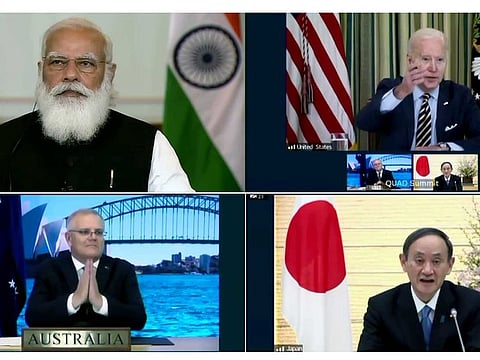How relevant is the Quad grouping?
There appears to be a lack of clarity among its members about the objectives and aims

The leaders of Australia, Japan, India, and the US came together for a virtual summit for the first time on 12 March, 2021. This not-so-new grouping is being called the Quadrilateral Security Dialog or Quad. Though this Quad name is relatively new, the idea had originated in the post-Tsunami period in December 2004, when the US, Australia, and Japan joined India for rescue and relief operations in the Indian Ocean region.
To turn the cooperation into a formal grouping was first mooted by Japanese Prime Minister Shinzo Abe in 2007, keeping China’s rise in mind. These countries held even a joint naval exercise in 2007, but Australia withdrew from it soon after as it didn’t want to provoke China. The US and India were also reluctant to be seen as forming an anti-China club.
The Quad revived again in 2017 on the ASEAN summit’s sideline in Manila, when the four countries came to be led by leaders of a similar political class, Trump in the US, Shinzo in Japan, Turnbull in Australia, and Modi in India. Though the idea of Quad has been for nearly two decades and it has got a formal existence for more than three years, there is considerable confusion over the rationale of its existence.
Also Read: Why the right-wing loves to hate Sweden?
Dialogue on security issues
As the name suggests, it is supposed to be a forum where four countries can be engaged in a dialogue on security issues. However, in the 21st century, the concept of security covers almost everything, and dialogue does not mean any commitment. So, some commentators paint it as an association, and some it as an alliance.
If it is an association, then the association of what? Quad is neither a regional association nor even an ideological fraternity. No one can argue that these four countries represent the Indo-Pacific region as at least 20 more are missing from the list.
The first Summit’s joint statement claims that “it seeks to uphold peace and prosperity and strengthen democratic resilience, based on universal values”. In the last few weeks, two of its members have also openly differed in the UN Security Council on supporting democracy and human rights, particularly in Myanmar and Tigray.
Some commentators try to project Quad as an alliance against China and even brand it as the ‘Nato of Asia’. They forget that China is not the Soviet Union, and the US and China are not engaged in an open confrontation.
A day before the Quad virtual summit, the US State Department spokesman played down the China factor in the formation of Quad — “It (Quad) was established not to counter one single threat or to focus on one single issue.” The US understands its limitations in pursuing an open policy of containing China.
Quad is not a military alliance, and it is improbable that it is going to be one. Japan and Australia have their bilateral security arrangements with the US. For over 60 years, the US is committed to Japan’s defence, and 55,000 of its military personnel are stationed in Japan. The US deploys most of its advanced and powerful military assets in Japan and Japan receives 90% of its defence imports from the US.
Like Japan, the defence cooperation between Australia is old and strong. Though Australia became part of the ANZUS Security Treaty in 1951, it has been a close partner in all American wars since the 2nd World War. At present, Australia gets 60% of its defence imports from the US.
A Nato-like arrangement
While China doesn’t pose a direct military threat to the US and both Japan and Australia have the US support commitment, there is very little interest among them to include India in a Nato-like arrangement. Almost 86% of Indian military equipment is of Russian origin.
Among the four ‘Quad’ countries, India only has a contested land border with China. The territorial dispute and even limited hostilities between China and India will not pose any threat to other’s core national interests.
At the same time, China will always tempt to test the Quad’s resolve directly or, with its close ally Pakistan. Considering the geographical location, it is also for India’s interest not to be part of a military alliance with external powers but to seek its territorial security using smart diplomacy within South Asia.
Quad not only lacks strategic clarity but also has no clear agenda. Everyone tries to define it as visually challenged describes an elephant. Quad claims to be an association of countries believing in democracy and human rights. In that case, it should include other countries in the Indo-Pacific region.
All these countries have strong economic ties with China, and China is also their largest trading partner. Like in 2007, any one of them is also very likely to go soft on China when that suits their interests. Thus, the lack of clarity about the objective and serious doubts over the countries’ commitment regarding any common cause makes the Quad nothing more than a talk shop.
Sign up for the Daily Briefing
Get the latest news and updates straight to your inbox








